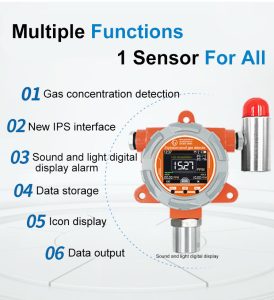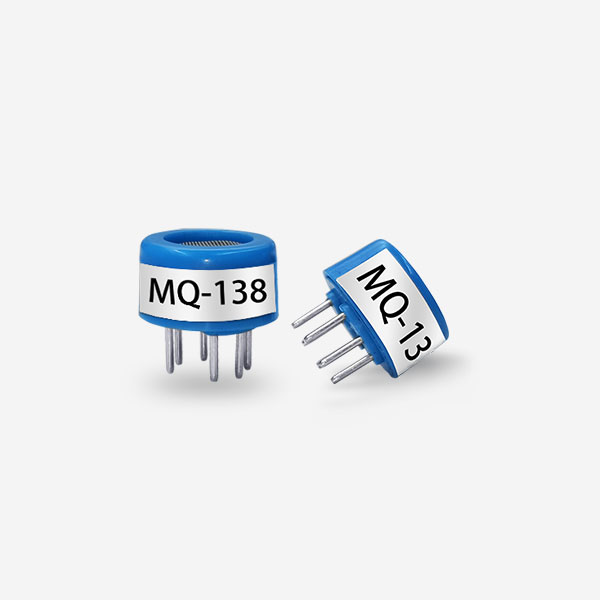-
The Role of Smart Gas Sensors in Modern Environmental Monitoring Systems
- Smart gas sensors have emerged as pivotal components in modern environmental monitoring systems, playing a crucial role in detecting and analyzing various gaseous pollutants in the atmosphere. With the increasing awareness of environmenta……
- Chat Online
-
Description
-
Electrochemical Sensors: These sensors measure the electrical current generated by a chemical reaction between the target gas and an electrolyte. They are commonly used for detecting gases like CO, NOx, and SO2.
-
Metal Oxide Semiconductor (MOS) Sensors: MOS sensors operate by measuring changes in electrical conductivity when gases adsorb onto the sensor surface. They are effective in detecting a wide range of gases, including VOCs and hydrogen (H2).
-
Optical Sensors: Optical sensors use light absorption, scattering, or fluorescence to detect gases. They are particularly useful for detecting gases like methane (CH4) and ammonia (NH3).
-
Catalytic Bead Sensors: These sensors utilize a catalytic material that reacts with the target gas, causing a temperature change that can be measured. They are typically used for detecting flammable gases like hydrogen (H2) and methane (CH4).
-
Photoionization Detectors (PIDs): PIDs use ultraviolet light to ionize the target gas, creating a current that can be measured. They are effective for detecting a variety of VOCs.
-
High Sensitivity and Selectivity: Smart sensors can detect low concentrations of target gases with high specificity, minimizing false positives and negatives.
-
Real-Time Data: Smart sensors provide continuous, real-time data, allowing for immediate response to environmental changes.
-
Longevity and Durability: Advanced materials and designs enhance the lifespan and durability of smart sensors, reducing maintenance and replacement costs.
-
Compact and Portable: Smart sensors are often small and lightweight, making them easy to deploy in various environments.
-
Data Integration: Smart sensors can be integrated with data processing algorithms and communication technologies, enabling remote monitoring and data analysis.
Smart gas sensors have emerged as pivotal components in modern environmental monitoring systems, playing a crucial role in detecting and analyzing various gaseous pollutants in the atmosphere. With the increasing awareness of environmental health and safety, the demand for accurate, reliable, and real-time gas detection has surged. This article delves into the significance of smart gas sensors, their underlying technologies, applications, challenges, and future prospects in the realm of environmental monitoring. By examining the integration of smart sensors within comprehensive environmental monitoring systems, we aim to highlight their transformative impact on our ability to assess and manage environmental risks.
1. Introduction
Environmental monitoring is a critical aspect of ensuring the health and safety of ecosystems and human populations. With industrialization and urbanization accelerating, the release of harmful gases into the atmosphere has become a significant concern. These pollutants, including carbon monoxide (CO), nitrogen oxides (NOx), sulfur dioxide (SO2), volatile organic compounds (VOCs), and ammonia (NH3), can have detrimental effects on air quality, leading to respiratory diseases, cardiovascular problems, and even premature death.
To address these challenges, environmental monitoring systems have evolved, incorporating advanced technologies to detect and quantify gaseous pollutants. Among these technologies, smart gas sensors stand out due to their ability to provide real-time, accurate, and reliable data. This article explores the role of smart gas sensors in modern environmental monitoring systems, detailing their technological advancements, applications, and the challenges they face.
2. Overview of Smart Gas Sensors
Smart gas sensors are devices capable of detecting and measuring the concentration of specific gases in the atmosphere. Unlike traditional sensors, which often rely on simple electrochemical or optical principles, smart sensors integrate advanced materials, microelectronics, and data processing algorithms to enhance their performance.
2.1 Types of Smart Gas Sensors
Smart gas sensors can be categorized based on their sensing principles, including:
2.2 Advantages of Smart Gas Sensors
Smart gas sensors offer several advantages over traditional sensors:
3. Applications of Smart Gas Sensors in Environmental Monitoring
Smart gas sensors have a wide range of applications in environmental monitoring, including:
3.1 Air Quality Monitoring
Smart gas sensors are essential for monitoring air quality in urban and industrial areas. By detecting pollutants like CO, NOx, SO2, and VOCs, they help assess the health risks associated with air pollution and inform policy decisions aimed at reducing emissions.
3.2 Emission Monitoring
In industrial settings, smart gas sensors are used to monitor emissions from factories, power plants, and vehicles. This data is crucial for ensuring compliance with environmental regulations and identifying opportunities for reducing emissions.
3.3 Greenhouse Gas Monitoring
Smart sensors are also used to monitor greenhouse gases like carbon dioxide (CO2) and methane (CH4). By tracking their concentrations in the atmosphere, researchers can better understand their impact on climate change and develop strategies for mitigation.
3.4 Indoor Air Quality Monitoring
Indoor air quality is often worse than outdoor air quality due to factors like poor ventilation, building materials, and household chemicals. Smart gas sensors can detect pollutants like formaldehyde, benzene, and radon, helping to create healthier living and working environments.
3.5 Disaster Response and Management
Smart gas sensors play a critical role in disaster response and management. In the aftermath of fires, chemical spills, or industrial accidents, they can detect harmful gases and provide real-time data to emergency responders, enabling them to make informed decisions and protect public safety.
4. Challenges and Limitations of Smart Gas Sensors

Despite their many advantages, smart gas sensors face several challenges and limitations:
4.1 Cross-Sensitivity and Interference
Smart sensors can be cross-sensitive to multiple gases, leading to false positives and negatives. Interference from environmental factors like humidity, temperature, and pressure can also affect sensor performance.
4.2 Calibration and Maintenance
Smart sensors require regular calibration and maintenance to ensure accurate and reliable data. This can be challenging in remote or harsh environments, where access to calibration gases and tools may be limited.
4.3 Data Integration and Processing
Integrating smart sensor data into existing environmental monitoring systems can be complex. Data processing algorithms and communication technologies must be robust and scalable to handle large volumes of real-time data.
4.4 Cost and Availability
The cost of smart gas sensors can be prohibitive for some applications, particularly in developing countries. Additionally, the availability of certain sensor types may be limited, depending on the target gas and application.
5. Future Directions and Innovations
The field of smart gas sensors is rapidly evolving, with ongoing research and development focused on overcoming current challenges and enhancing sensor performance.
5.1 Advanced Materials and Nanotechnology
Advances in materials science and nanotechnology are leading to the development of new sensor materials with improved sensitivity, selectivity, and stability. These materials, such as graphene, metal-organic frameworks (MOFs), and quantum dots, offer exciting opportunities for enhancing sensor performance.
5.2 Machine Learning and Artificial Intelligence
Machine learning and artificial intelligence (AI) algorithms are being integrated into smart sensor systems to improve data processing and analysis. These algorithms can help identify patterns, predict trends, and provide actionable insights based on sensor data.
5.3 Wireless Communication and IoT
The integration of wireless communication technologies and the Internet of Things (IoT) is enabling remote monitoring and real-time data sharing. This allows for more comprehensive and efficient environmental monitoring systems, with data from multiple sensors aggregated and analyzed in real-time.
5.4 Standardization and Interoperability
Efforts are underway to standardize smart sensor technologies and ensure interoperability between different systems. This will facilitate the integration of sensor data into existing environmental monitoring frameworks and promote wider adoption of smart sensor technologies.
6. Conclusion
Smart gas sensors are playing an increasingly important role in modern environmental monitoring systems. Their ability to provide real-time, accurate, and reliable data on gaseous pollutants is crucial for assessing and managing environmental risks. Despite facing challenges and limitations, ongoing research and development are driving innovations in sensor technology, materials, and data processing. As these technologies continue to evolve, smart gas sensors will play an even greater role in protecting our environment and ensuring the health and safety of ecosystems and human populations.
-
Recommend:
-
-
The Role of Smart Gas Sensors in Modern Environmental Monitoring Systems
Smart gas sensors have emerged as pivotal components in mod…
-
The Vital Role of Gas Sensors in Modern Safety and Environmental Monitoring Introduction
In an era where industrialization and urban development are…
-
Gas Detector Applications in Environmental Monitoring
In the modern world, environmental monitoring has become a …
-
Gas Sensor Technology: A Comprehensive Review
Gas sensor technology has undergone significant advancement…
-
 : +86 155 8830 2704
: +86 155 8830 2704 : jxdziot@gmail.com
: jxdziot@gmail.com
